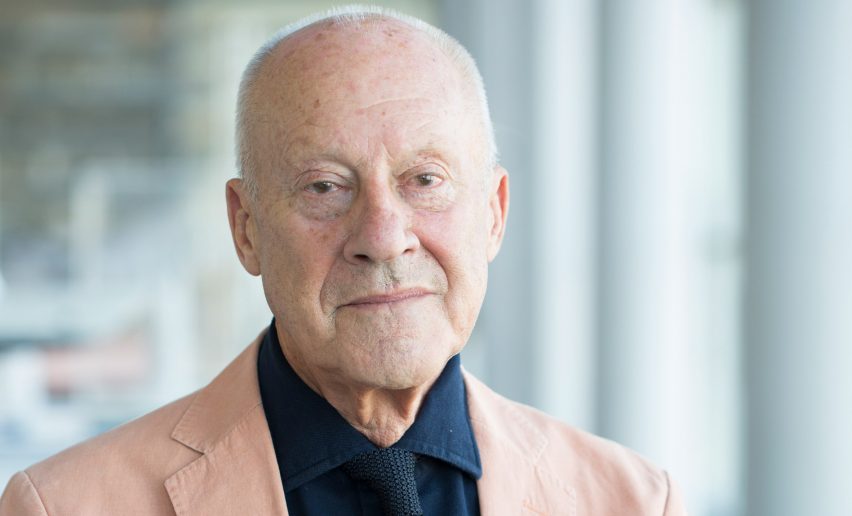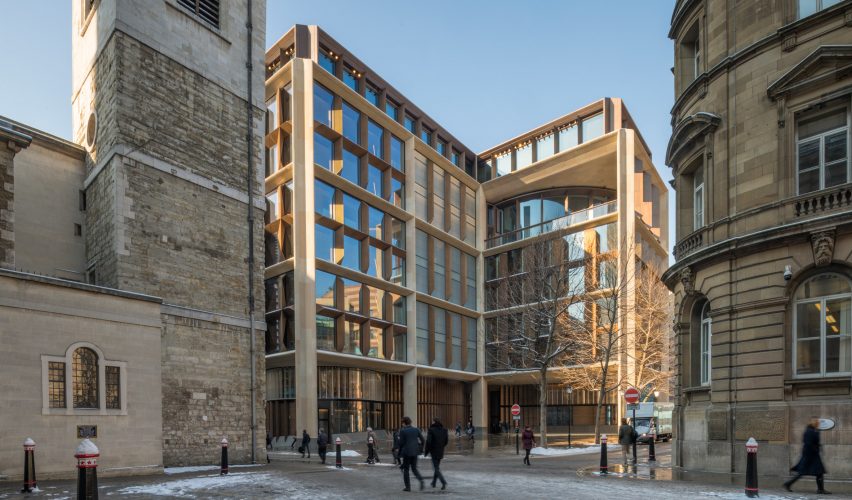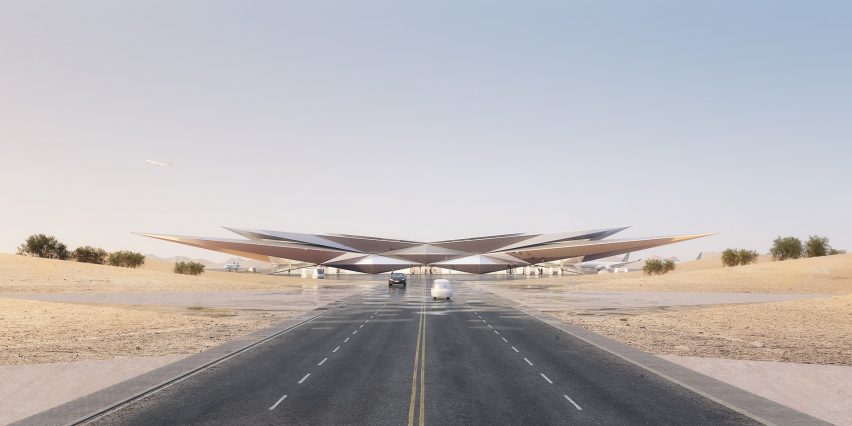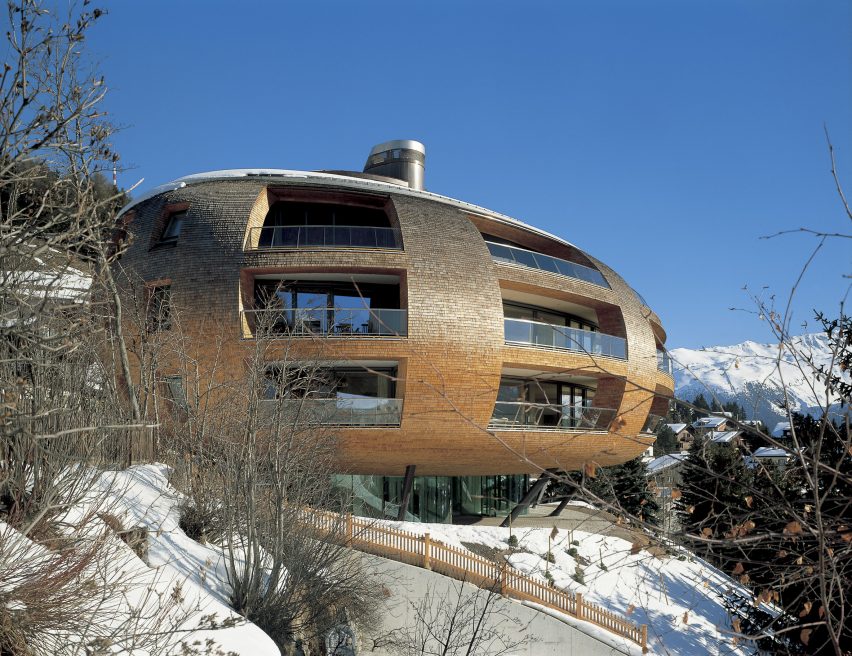
"There are a lot of dangerous myths" about sustainability says Norman Foster
British architect Norman Foster explains his studio's approach towards sustainability and his views on concrete, timber, aviation and Architects Declare in this exclusive interview.
Speaking to Dezeen at Foster + Partners' London headquarters, he defended concrete buildings against what he branded "dangerous myths", argued the studio has "done more timber buildings than probably any of the other architects" and explained why it withdrew from Architects Declare.
Foster said the studio, which is the UK's largest, aims to create buildings that are both sustainable and improve people's lives.
"The prevailing view is, 'oh my god, we're all going to suffer because we have to create buildings which are better for the planet – poor us we're going to suffer as a consequence,'" he said.
"It should be the reverse. It should be: buildings which are good for the planet are going to be closer to nature. They're going to be buildings which are not sealed boxes recirculating refrigerated air, which is not the healthiest."
"A group of us had a utopian vision of what buildings might be"
According to Foster, designing sustainable buildings has been ingrained in the studio's ethos in a "seamless transition" from his first studio Team 4, which was run with Richard Rogers, Su Brumwell and Wendy Cheesman.
"The reality is that a group of us had a utopian vision of what buildings might be," he said.
"They were essentially craft-based, but they were anti-sprawl. They were compact, they conserve nature. They were developed on some timeless themes like the row house, which is not exactly a kind of modern movement invention."

Foster argues that over the past 55 years, Foster + Partners has been designing buildings with an environmental focus that "seek to challenge the status quo" by "reducing energy and encouraging contact with the natural world". He cites the Reichstag in Berlin, HSBC tower in Hong Kong, Apple campus in California and Bloomberg HQ in London as examples.
"I'd like to think that what we did as a fledgling practice was to try to mirror with architecture what the emerging expression of the age was in the 1960s," he said.
"It was, in a way, creating an architecture that was rooted in an ecological movement, which was not called green – that hadn't been invented," Foster continued.
"So that's the roots of where we are now. And so that's been an unspoken part of our DNA."
Airport criticism "well-intentioned, but misplaced"
Foster believes that sustainability is ingrained in Foster + Partners, which in 2019 published a sustainability manifesto. However, in recent years his studio has clashed with others in the UK architecture profession over its approach.
Foster + Partners was one of only two of the country's top 10 largest studios that declined to endorse a RIBA sustainability report backed by nearly 250 built environment organisations. The studio criticised the report, claiming it contradicted the Paris Agreement treaty on climate change.

In 2019 the studio faced widespread criticism over its approach to aviation. This led to the studio withdrawing from the Architects Declare climate change group after facing calls to halt work on an airport in Saudi Arabia.
However, Foster believes that the focus on airports is "misplaced".
"We need to think holistically," he said. "We're not withdrawing from agriculture-related buildings, we're not withdrawing from buildings relating to shipping."
"I think that it's well-intentioned, but misplaced, and I think we have to have a more holistic, wider view of reducing imprints. We should be going beyond."
Foster advocates nuclear power
The Pritzker Architecture Prize-winning architect believes that the greater adoption of nuclear power can have a huge impact on improving the environmental credentials of aviation.
"If we have an abundance of clean energy, you can address the issue of slums where a significant proportion of humanity – a billion people – don't have sanitation, access to power and clean water," he said.
"With the generosity of clean energy, you can convert seawater to jet aviation fuel. So overnight without any changes to the hardware, the engines, the whole fleet of aircraft can go green," he continued.
"In that process, you are decarbonizing the oceans, because the oceans are a significant carbon sink. It's a win-win situation, which is a rather long-winded explanation of why eventually, we did withdraw from Architects Declare."
"There are a lot of dangerous myths about materials"
Foster + Partners has also been criticised over its material choices and focus on in-use performance over embodied carbon. Foster defended the use of concrete, which is produced by an industry that accounts for around seven per cent of the world's carbon dioxide emissions.
During judging for the 2021 Stirling Prize, Foster was a vocal advocate for the concrete Kingston University London – Town House designed by Grafton Architects, which ended up winning the award.
"I think that there are a lot of dangerous myths about materials, recycling and sustainability," he told Dezeen. "We had a very intense debate on this in the jury of the Stirling prize. It wasn't about the material, it was about how you use that material."

Foster argues that concrete can have many benefits – citing the Apple campus in California as an exemplary concrete building because its design reduces the use of additional materials for fit-outs.
"Not to underestimate the energy embodied in that process, but if you took the Apple building – the concrete structure is reinforced, so it's working structurally – obviously, nothing new," he explained.
"You're running small bore pipes through it, so you can channel hot or chilled water so it's eliminating all the traditional ductwork," he continued.
"So you're shrinking the height of that building. But you're maintaining the generous floor-to-ceiling height for the occupants, you're reducing the external envelope and the concrete is the finish – so you're not lining."
"We've done more timber buildings than probably any of the other architects"
Despite extolling the benefits of concrete, Foster pointed out that the studio has also designed numerous timber buildings including his own home in the Chesa Futura building in St Moritz, Maggie's in Manchester and the Acciona building in Madrid.
"You'll find we've done more timber buildings than probably any of the other architects that you might be checking out," he said.
Read on for the full interview with Foster:
Tom Ravenscroft: How were the ideals of flexibility and sustainability embedded in high-tech architecture?
Norman Foster: There was an almost seamless transition between the original Team 4, which was Richard, myself, Wendy and Georgie, her sister – who had the only status as an architect, and Sue. The reality is that a group of us had a utopian vision of what buildings might be. They were essentially craft based, but they were anti-sprawl, they were compact, and they conserve nature.
They were developed on some timeless themes like the row house, which is not exactly a kind of modern movement invention.
And then there was Reliance Controls, which transitioned into the birth of this practice. But what I'd like to think is that what we did as a fledgling practice was to try to mirror with architecture, what the emerging expression of the age was in the 1960s.
We were influenced not just by pop music and the rebellion, but in a way everything was being reassessed – gender, rituals, everything was subject to questioning. I think our real relevance to the architecture that followed was Rachel Carson, the Silent Spring, the realisation that ecosystems were being destroyed by hostile pesticides that resulted in the banning of DDT.
You had the Earthrise photograph, where the astronauts said we went to discover the moon, instead, we discovered the Earth. That photograph and its realisation of a razor-thin atmospheric protection that really was life, led Bucky [Richard Buckminster Fuller] to promote the fragility of the planet through his operating manual for planet Earth.
If you look at all the work, which was projected at that time, in Gomera, it was about using the sun's power to desalinate salt water into drinking water. The bathrooms were using human waste to convert it into fertiliser to recreate a new kind of agriculture.
It was building on the topography from the past agricultural age to encourage a new version of tourism ecotourism to avoid building ring roads, and airports. So and in some ways, that mirrored almost the Back to Nature movement, which Stewart Brand captured with the Whole Earth Catalogue, which was almost again like the transition between the analogue and the digital age in terms of proliferating free information without a kind of commercial overtone.
If you look at Burke and Howard's diagram, of that time, they were about breathing buildings working with nature, capturing sunlight, reflecting those suns, with mirrors into the heart of the plant building there, again about recycling, conserving water energy.
So it was, in a way, creating an architecture that was rooted in an ecological movement, which was not called green, that hadn't been invented. So that's the roots really, of where we are now. And that's been an unspoken part of our DNA.
And that doesn't mean that I'm kind of crowing and say, we're there, I don't think we're anywhere near. But in terms of wherever there leads us, it's somewhere that we've been seeking from the late 1960s.
If you actually look at the official website of the Reichstag, it is absolutely remarkable, the dramatic reduction in greenhouse gas from 90 odd per cent spewing out to a mere four per cent. And that building is using every weapon in the armoury. I mean, it's using solar, it's using vegetable oil to power co-generators. And all that is, again, going back to the early 90s. It's an energy manifesto.
Tom Ravenscroft: How does this ethos translate to your more recent buildings and your airports?
Norman Foster: I think that the move that we made with Stansted, which has subsequently been widely adopted as a model in many manifestations, is essentially taking all the stuff that's normally on a roof, opening that up to the natural world and natural light and reducing energy. I think that's a worthy objective.
If we look at the contribution to global warming, air travel is minuscule compared with so many other sectors of shipping, ground transport and agriculture. That's not in any way to denigrate the importance of reducing that aspect.
But if we come to energy, just look at the statistics for mortality for deaths. Nuclear is far and away the safest taking every catastrophe this has happened. It's by a huge margin. We're talking literally a few hundred compared with hundreds of thousands. And what is regarded by its detractors as its greatest problem is actually its greatest strength.
We cannot control the billions of tons of dirty gases, which go out into the atmosphere and kill an estimated 10 million people, mostly kids through poor air quality. It's a minuscule amount compared with that and it's totally controllable.
If we have an abundance of clean energy, you can address the issue of slums where a significant proportion of humanity – a billion people – don't have sanitation, access to power and clean water. With the generosity of clean energy, you can convert seawater to jet aviation fuel. So overnight without any changes to the hardware, the engines, the whole fleet of aircraft can go green. In that process, you are decarbonizing the oceans, because the oceans are a significant carbon sink. So you're de-acidifying the oceans. It's a win-win situation, which is a rather long-winded explanation of why eventually, we did withdraw from Architects' Declare.
Tom Ravenscroft: Do you think you have a different understanding of the word sustainability to others in the UK architecture community?
Norman Foster: We need to think holistically. We're not withdrawing from agriculture-related buildings, we're not withdrawing from buildings relating to shipping. I think that it's, it's well-intentioned, but misplaced, and I think we have to have a more holistic, wider view of reducing imprints. We should be, we should be going beyond.
I don't want it to sound in any way self-promotional, but if you take Apple Park, and it's a carbon-neutral building, and you've recycled 98 per cent of the 24, buildings and you're using that recycled material, in the new buildings. And you plant 10,000 trees and those trees are absorbing carbon dioxide.
That I guess is one definition of something that's climate restorative instead of just being climate neutral. It's going beyond and saying let's capture some carbon through this building. It's also about the health of the occupants of the building. So if you're creating where there was asphalt, instead, you're creating landscape greenery. You're encouraging biodiversity.
Tom Ravenscroft: So you believe the aim is not to try and hit one metric?
Norman Foster: The prevailing view is, 'oh my god, we're all going to suffer because we have to create buildings, which are better for the planet – poor us we're going to suffer as a consequence.
It should be the reverse. It should be buildings, which are good for the planet are going to be closer to nature. They're going to be buildings, which are not sealed boxes, recirculating refrigerated air, which is not the healthiest.
Tom Ravenscroft: Do you have a model of the Commerzbank skyscraper here?
Norman Foster: No, but the Bloomberg is a more sophisticated version, Hong Kong bank there was using seawater cooling again and shading, the Gherkin is pulling air through the spiral...
Tom Ravenscroft: So you are saying that there are learning moments in each of these projects. I wouldn't want to hazard a guess at how many projects Foster + Partners has completed.
Norman Foster: Prolific. Lots of experiments. We were just reflecting this morning that whether it's a Fred Olsen in the '90s where the dockers were walking on carpet, which was absolutely unheard of as every office was lino. Whether it's Bloomberg, Steve Jobs – they are all seeking to challenge the status quo. And all in ways, which are reducing energy and encouraging contact with the natural world.
Commerzbank, of course, has gardens which spiral up as well. So it's a breathing building, it's not just reducing the energy.
A lot of what is underpinning this is to a degree, subjective and intuitive. In other words, it's saying, if you can look up and see the sky, if you can look out of a window, if you have contact with nature – it's going to be good for you.
But we could never prove it. But since then people like Joe Allen at Harvard have scientifically proved it. They created a facility where you can have guinea pigs in cubicles, the environment, the physical environment, can be created by a plant run below, which is exactly what we did to test out the Bloomberg building. We built a huge testbed office about the size of two of these structural bays here.
Tom Ravenscroft: How do material choices impact this thinking?
Norman Foster: I think that there are a lot of dangerous myths about materials, recycling and sustainability. We had a very intense debate on this in the jury of the Stirling prize.
Tom Ravenscroft: For your project?
Norman Foster: No, Kingston. In that internal debate I was talking about Apple as an example because at that point, we hadn't decided on the winner. The subject of the role of concrete. It wasn't about the material, it was about how you use that material. As we demonstrated, at Apple, you could crunch the 24 buildings and you could reuse the concrete that was there in the new building.
That's not to underestimate the energy embodied in that process. But if you then took the Apple building, because the concrete structure is reinforced, so it's working structurally – obviously, nothing new. If you're running small bore pipes through it, so you can channel hot or chilled water. And it's eliminating all the traditional ductwork.
So you're shrinking the height of that building. But you're maintaining the generous floor-to-ceiling height for the occupants, you're reducing the external envelope and the concrete is the finish – so you're not lining. You start to compare this with a traditional building. That debate was important in terms of the jury's decision.
Tom Ravenscroft: It sounds like you maybe won that debate because they went on to win the Stirling Prize.
Norman Foster: Yes.
Tom Ravenscroft: Sounds like you made a convincing argument.
Norman Foster: Well, it was very pertinent to that. Because, when the jury was able to visit it, they could see that there were no internal linings. The concrete was the building, but it was doing all those other things. So it was looking at the use of the material with relatively fresh eyes and not necessarily stereotyping.
Tom Ravenscroft: So you are saying that concrete in itself is not necessarily wrong?
Norman Foster: It's how you use this material. And then, of course, you have to also realise that if you were talking to our lead structural engineers. He will be telling you about research into low carbon. So you're using less of the material, you're decarbonizing that material and then you're making that material perform more roles.
So it's the viral mental membrane, it's the structure is the finishes. And you do get to the point where the structure is the architecture and the architecture is the structure.
Tom Ravenscroft: With your prolific output, you seem to favour concrete and not focus too heavily on timber.
Norman Foster: Well, first of all, check out Acciona, which creates a public garden. It's the most sustainable building that we've done. It lines up perfectly with the Paris accord. It recycles an industrial building. It's in Madrid is done by the young team there. It was presented at COP26 as the most sustainable project that we've done in our history. It uses timber extensively.
Note that I live in a predominantly timber building – Chesa Futura. The foundation has just done a family building for use by the American friends of the foundation. It uses a minimum amount of steel, but is otherwise a totally dominant timber.
Look at Maggie's in Manchester, which is that timber building. You'll find we've done more timber buildings than probably any of the other architects that you might be checking out.
Tom Ravenscroft: Well you have done more buildings than anyone else! So timber can be a part of sustainable buildings. I just don't associate Foster with timber.
Norman Foster: Well, that's quite a collection. And Row New York, which is about to go on site.
Tom Ravenscroft: So timber does have a role?
Norman Foster: It's how you use the material.